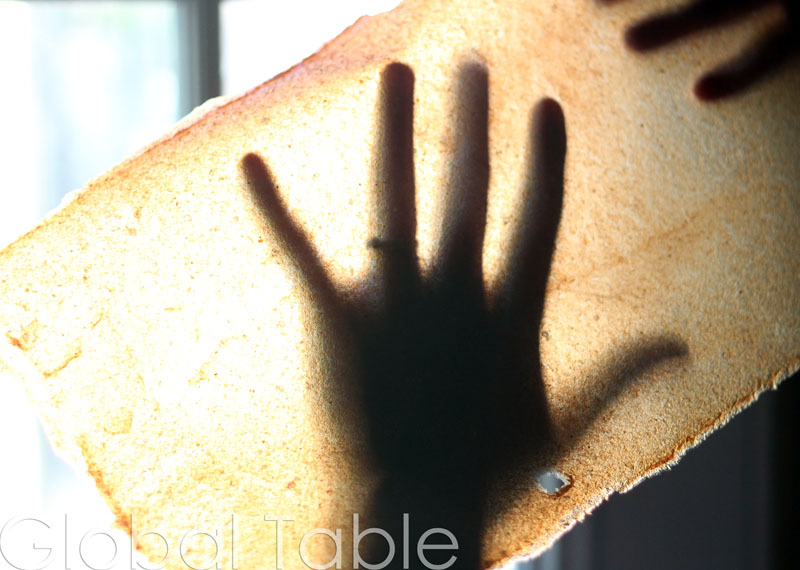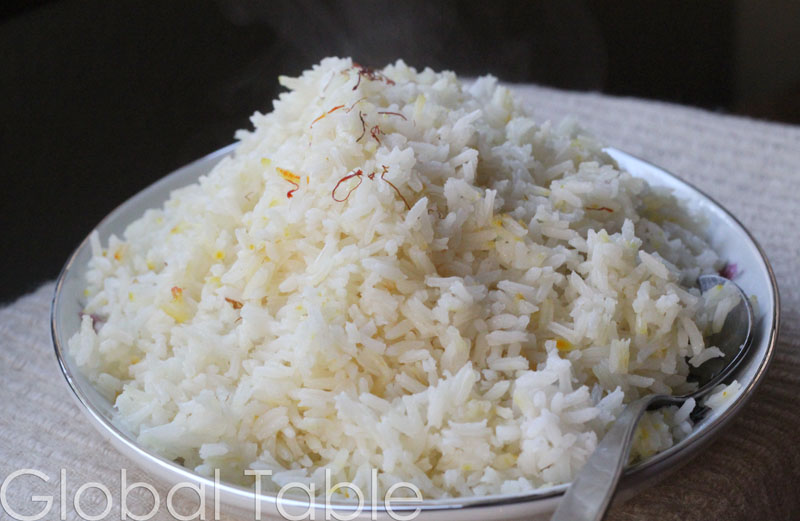Serves 4 Shrimp balls blend the flavors of the Middle East with India. Though these are traditionally stuffed with minced onion, I prefer the simplicity of unfilled balls. If you like spicy food, add a sprinkle of cayenne. The way the recipe stands, however, this dish is mild, but wonderfully flavorful. TIP: Use the cheapest shrimp because you are just going to puree it anyway. Ingredients: 1 lb cleaned shrimp 1 Tbsp cilantro 1/4 tsp ground turmeric 1/2 – 1 tsp salt 1/2 cup brown rice flour 1/3 cup ghee or butter 1 onion, minced baharat powder: 1 tsp paprika 1/4 tsp nutmeg 1/4 tsp black pepper 1/4 tsp coriander 1/4 tsp cumin 1/4 tsp cinnamon 1/8 tsp cloves 1/8 tsp cardamom the rind of 1/2 a lemon, grated 1 tsp tamarind paste 1 cups warm water 1 15 oz can diced tomatoes 1/2 tsp chili powder 2 Tbsp sugar Method: For the shrimp balls: 1. In a food processor blend into a paste shrimp, cilantro, turmeric, salt, and rice flour. Chill until needed. For …
Read More
Serves 4 Mulhammar is a slightly sweet rice pilaf is wonderful with spicy food. You’ll love the taunting aroma of rosewater, saffron, and cardamom. Everything is very subtle and mild. Ingredients: 1/2 tsp saffron threads 3 cardamom pods, cracked 2 Tbsp rosewater 6 cups water 1 Tbsp salt 2 cups basmati rice 1/4 cup sugar 1/4 cup ghee or melted butter Method: 1. Combine saffron, cardamom and rosewater in a small bowl. I then used a spoon to mash the saffron mixture into the sugar. 2. In a medium pot, bring water and salt to a boil. Meanwhile, rinse rice under cool water until water runs clear. 3. Add rice to boiling water and cook 8 minutes uncovered. Stir every few minutes. Drain. 4. Put rice back in pot and add saffron mixture over the top along with the melted ghee or butter. With the handle of a wooden spoon, poke a few holes in rice. Cover with lid and let steam over very low heat for about 20 minutes, or until tender. Serve hot. …
Read More

Makes about 8 strips Feel free to play around with this recipe to make flavors and combinations that you like. Be sure to check out the tips in Technique Thursday. Time may vary on when this is done, depending on your oven. Please check multiple times so as not to overcook this! Ingredients: 12 ounces dried apricots, quartered 1 cup water 2 Tbsp honey 4 cardamom pods Method: 1. In a small pot, simmer dried apricots with water, honey, and cardamom pods. Simmer about 20 minutes. 2. Carefully remove cardamom pods. Using an immersion blender, puree mixture. The mixture should be a bit thicker than applesauce. 3. Line a baking sheet with silpat (or microwave safe saran wrap). Pour apricot mixture over silpat about 3/8″ thick. Spread evenly. 4. Place baking sheet in a warm oven for 6-8 hours, or until apricot leather is just tacky to the touch. Store, covered in a cool, dry place, refrigerate or freeze. Apricot Fruit Leather | Quamar-el-Deen Votes: 0 Rating: 0 You: Rate this recipe! Print Recipe …
Read More
Serves 4 Make this dish a day ahead to allow time for the flavors to mingle. Uukkous Al-Badinjan blows baba ganoush out of the water! Ingredients: 3 eggplants 4 cloves garlic, crushed 2 Tbsp olive oil 1/4 tsp cayenne 1 1/2 tsp sweet paprika 2 Tbsp lemon juice 1/4 cup fresh parsley, minced 1/2 – 1 tsp salt Method: 1. Using a fork, poke eggplants all over. Roast eggplants at 350F for about 1 hour or until soft. NOTE: Today it’s pretty hot in Oklahoma, so I decided to keep the house cool and grill the eggplants. Grill at 350F for about an hour or until soft. 2. Remove from oven and let cool until you can handle the eggplants. With a knife, split eggplants open and scoop out all the flesh into a food processor or blender. Or if you’re like me, into a bowl and use your immersion blender. 3. Add remaining ingredients and puree. Taste and adjust seasonings if necessary. Chill and serve with flatbread or as an accompaniment to main meal. …
Read More
For those of you about to dig into the food of Bahrain, these videos will give you a glimpse into the culture and lifestyle.
Read More

Hope your week was lovely! Here are a few fun facts about food and culture in Bahrain: – Souqs are the markets in Bahrain: Historically, souqs were held outside of cities in the location where a caravan loaded with goods would stop and merchants would display their goods for sale. Souqs were held when there was a caravan or more available. At that time, souqs were more than just a market to buy and sell goods; they were also major festivals and many cultural and social activities took place in them. Later, due to the importance of the marketplace and the growth of cities, the locations of souqs shifted to urban centers. (source: Wikipedia) – Rumor has it there are no Bahraini restaurants in Bahrain. Sounds unlikely, but this advice holds true, no matter where you travel: if you want to eat authentic food, go to someone’s house. – Italian and Lebanese restaurants are preferred by locals. – When drinking ‘gahwa’ (Arabic coffee) be sure to shake your cup side to side when you are full. …
Read More
Let’s just get something out in the open. Fruit Roll-ups are no good. They’ve got corn syrup and hydrogenated oil in them. Take it from me, life is much better if you make the nummy sweet snacks yourself! And I have good news – it’s easy. But you have to promise not to call them Fruit Roll-ups. The proper term for the homemade goodness is fruit leather. Sounds so much more John Wayne, don’t you think? The Basics: 1) Puree Fruit with seasonings and water. (Make the texture like apple sauce. I used an immersion blender.) 2) Smear the puree around on a lined cookie sheet. 3) Dry it out in the oven for several hours (anywhere from 2-8 hours, depending on how watery the mixture is). (If you’re a fancy pants you can use a dehydrator, Or, if you’re mad cool, you can harness the power of the sun, like this gal) 4) Eat, Drink, and be Merry! That’s right, I said drink. You see, in the Middle East fruit leathers are rehydrated in …
Read More

In the traditional recipes I’ve oggled, Bahraini fuse Middle Eastern cuisine with spices from India. Sounds great to me! I’m always dragging my husband to both sorts of restaurants. How great that I’ll be able to eat both in one bite. I’m particularly looking forward to trying the variation on rice pilaf. Roasted Eggplant Dip (Uukkous Al-Badinjan) [Recipe] A tantalizing blend of roasted eggplant, garlic, olive oil, chili pepper, paprika, lemon juice, and parsley. This reminds me of a spicy baba ganoush, without the tahini. Bahraini Shrimp Balls (Chebeh Rubyan) [Recipe] Shrimp pureed with rice flour, turmeric, and cilantro. The shrimp paste is then formed into balls, stuffed with a seasoned onion mixture and simmered slowly in a chili tamarind sauce. Rosewater Rice Pilaf (Mulhammar) [Recipe] Basmati rice steamed rosewater, cardamom, saffron, ghee, and sugar. Although slightly sweet, this dish is not a dessert, but is served with main courses. Apricot Fruit Leather (Quamar-el-Deen) [Recipe] This “fruit roll-up” is eaten during Ramadan throughout the Middle East. For a variation, the leather can then be dissolved …
Read More

NOTE: In the time it took me to write this post the temperature dropped ten degrees and fits of rain sporadically fell on Tulsa. Although cold, rainy days are perfect for writing, I couldn’t help but think “Bah, rain.” (I’m working on my mom humor, what do you think?) All 700 square km of the island Kingdom of Bahrain is in the Persian Gulf. Bahrain is made up of many islands (some sources say 33, others say 40). The name means “two waters” and refers to the country’s water sources, salt (from the sea) and fresh (from the springs that bubble up and provide irrigation for crops). Although spring water is available for crops, not much can be grown in Bahrain, so imports are the main source of foods. This also means that Bahrain is particularly susceptible to outside influence on cuisine and culture (such as India who, by international trade, spread their love of turmeric and tamarind to Bahrain). The kingdom is very well-organized and is considered one of the most modern countries in the Middle East. Their …
Read More

Llokume was popularized in Eastern Europe and North Africa during the Ottoman empire. This recipe makes enough Turkish Delight to share. Bring the confection to a special friend or a party, and you will learn why Albanians are just one of many cultures that find this dessert delightful. (Makes approximately 50 pieces) Ingredients: For the candy: 4 cups granulated sugar 1 Tbsp real lemon juice 1 1/2 cup water, plus an additional 2 3/4 cups 1 cup cornstarch 1 tsp cream of tartar 1 Tbsp vegetable oil 1 tsp rose water 1 tsp orange extract yellow food coloring red food coloring For the coating: 2-3 lbs confectioners sugar 1- 1 1/2 cups cornstarch Method: SPECIAL NOTE: Be careful when cooking with boiling hot sugars. Only use glass or metal bowls/containers. No plastic. Day One: 1. In a medium, heavy-bottomed saucepan combine sugar, lemon juice, and 1 1/2 cups water. Bring to a boil over medium heat, stirring until the sugar dissolves. Reduce heat and simmer until the mixture reaches 240F, or soft ball, on a candy thermometer. Remove from heat. NOTE: …
Read More











